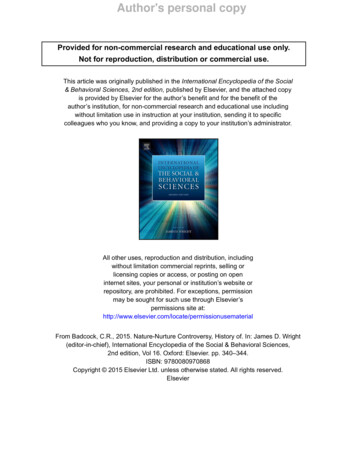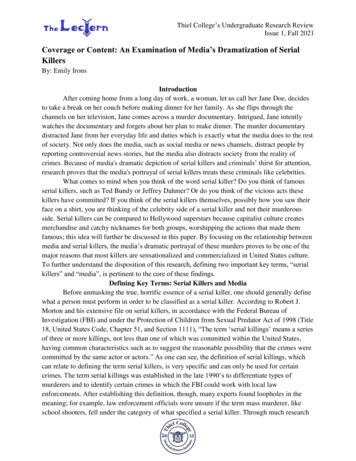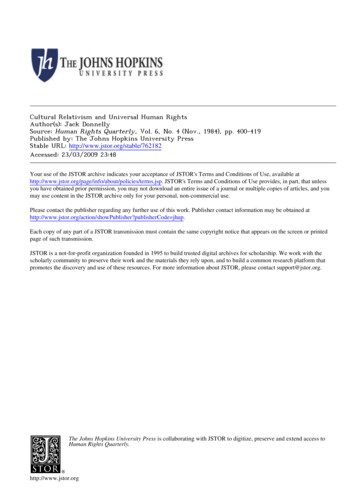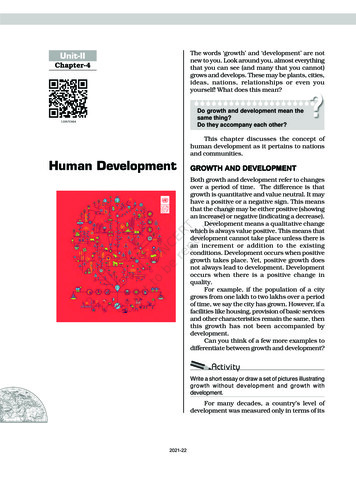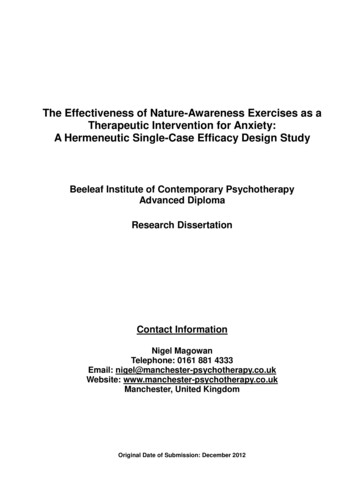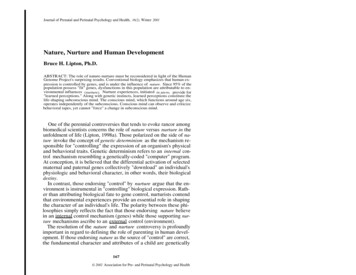
Transcription
Journal of Prenatal and Perinatal Psychology and Health, 16(2), Winter 2001Nature, Nurture and Human DevelopmentBruce H. Lipton, Ph.D.ABSTRACT: The role of nature-nurture must be reconsidered in light of the HumanGenome Project's surprising results. Conventional biology emphasizes that human expression is controlled by genes, and is under the influence of nature. Since 95% of thepopulation possess "fit" genes, dysfunctions in this population are attributable to environmental influences (nurture). Nurture experiences, initiated in utero, provide for"learned perceptions." Along with genetic instincts, learned perceptions constitute thelife-shaping subconscious mind. The conscious mind, which functions around age six,operates independently of the subconscious. Conscious mind can observe and criticizebehavioral tapes, yet cannot "force" a change in subconscious mind.One of the perennial controversies that tends to evoke rancor amongbiomedical scientists concerns the role of nature versus nurture in theunfoldment of life (Lipton, 1998a). Those polarized on the side of nature invoke the concept of genetic determinism as the mechanism responsible for "controlling" the expression of an organism's physicaland behavioral traits. Genetic determinism refers to an internal control mechanism resembling a genetically-coded "computer" program.At conception, it is believed that the differential activation of selectedmaternal and paternal genes collectively "download" an individual'sphysiologic and behavioral character, in other words, their biologicaldestiny.In contrast, those endorsing "control" by nurture argue that the environment is instrumental in "controlling" biological expression. Rather than attributing biological fate to gene control, nurturists contendthat environmental experiences provide an essential role in shapingthe character of an individual's life. The polarity between these philosophies simply reflects the fact that those endorsing nature believein an internal control mechanism (genes) while those supporting nurture mechanisms ascribe to an external control (environment).The resolution of the nature and nurture controversy is profoundlyimportant in regard to defining the role of parenting in human development. If those endorsing nature as the source of "control" are correct,the fundamental character and attributes of a child are genetically167 2002 Association for Pre- and Perinatal Psychology and Health
168Journal of Prenatal and Peennatal Psychology and Healthpredetermined at conception. Genes, presumed to be self-actualizing,would control organismal structure and function. Since developmentwould be programmed and executed by the internalized genes, thebasic role of the parent would be to provide nutrition and protectionfor their growing fetus or child.In such a model, developmental characters that deviate from thenorm imply that the individual expresses defective genes. The beliefthat nature "controls" biology fosters the notion of victimization andirresponsibility in the unfoldment of one's life. "Don't blame me forthis condition, I got it in my genes. Since I can't control my genes, Iam not responsible for the consequences." Modern medical science perceives of a dysfunctional individual as one possessing a defective"mechanism." Dysfunctional "mechanisms" are currently treated withdrugs, though pharmaceutical companies are already touting a futurein which genetic engineering will permanently eliminate all deviantor undesirable characters and behaviors. Consequently, we relinquishpersonal control over our lives to the "magic bullets" proffered by pharmaceutical companies.The alternative perspective, supported by a large number of lay people and a growing contingency of scientists, expands upon the role ofparents in human development. Those endorsing nurture as life's "control" mechanism contend that parents have a fundamental impact onthe developmental expression of their offspring. In a nurture-controlled system, gene activity would be dynamically linked to an everchanging environment. Some environments enhance the potential ofthe child, while other environments may induce dysfunction and disease. In contrast to the fixed-fate mechanism envisioned by naturists,nurture mechanisms offer an opportunity to shape an individual's biological expression by regulating or "controlling" their environment.In reviewing the nature-nurture controversy over the years, it is apparent that at times, support for nature mechanisms predominatesover the concept of nurture, while at other times the reverse is true.Since the revelation of the DNA genetic code by Watson and Crick in1953, the concept of self-regulated genes controlling our physiologyand behavior has prevailed over the perceived influence of environmental signals Removing personal responsibility in the unfolding ofone's life leaves us with the belief that almost all negative or defectivehuman traits represent a mechanical failure of the human molecularmechanism.By the early 1980s, biologists were fully convinced that genes "control" biology. It was further assumed that a map of the completedhuman genome would provide science with all the necessary infor-169. mation to not only "cure" all of mankind's ills, but also create a Mozartor another Einstein. The resulting Human Genome Project was designed as a global effort dedicated to deciphering the human geneticcode.The primary function of genes is to serve as biochemical blueprintsthat encode the complex chemical structure of proteins, the molecular"parts" from which cells are constructed. Conventional thought heldthat there was one gene to code for each of the 70,000 to 90,000 different proteins that make up our bodies. In addition to protein-codinggenes, the cell also contains regulatory genes that "control" the expression of other genes. Regulatory genes presumably orchestrate theactivity of a large number of structural genes whose actions collectively contribute the complex physical patterns providing each specieswith its specific anatomy. It is further presumed that other regulatorygenes control the expression of such traits as awareness, emotion, andintelligence.Before the project got off the ground, scientists had already estimated that human complexity would necessitate a genome (the totalcollection of genes) in excess of 100,000 genes. This was based upon aconservative estimate that there were in excess of 30,000 regulatorygenes and over 70,000 protein-coding genes stored in the human genome.When the results of the human genome project were reported thisyear, the conclusion presented itself as a "cosmic joke." Just whenscience thought it had life all figured out, the universe threw a biological curve ball. In all the hoopla over the sequencing of the humangenetic code and being got caught up in the brilliant technological feat,we have not focused on the actual "meaning" of the results. Theseresults overturn a foundational core belief embraced by conventionalscience.The Genome project's cosmic joke concerns the fact that the wholehuman genome consists of only 34,000 genes (See Science, 2001, 291,5507 and Nature, 2001, 409, 6822). Two thirds of the anticipated andpresumed necessary genes do not exist! How can we account for thecomplexity of a genetically-controlled human when there are not evenenough genes to code just for the proteins?The "failure" of the genome to confirm our expectations reveals thatour perception of how biology "works" is based upon incorrect assumptions or information. Our "belief' in the concept of genetic determinism is apparently fundamentally flawed. We cannot attribute thecharacter of our lives solely to the consequence of inherent genetic"programming." The genome results force us to reconsider the ques-
Journal of Prenatal and Perinatal Psychology and Healthtion: "From whence do we acquire our biological complexity?" In acommentary on the surprising results of the Human Genome study,David Baltimore (2001), one of the world's prominent geneticists anda Nobel prize winner, addressed this issue of complexity:But unless the human genome contains a lot of genes that are opaque to ourcomputers, it is clear that we do not gain our undoubted complexity over wormsand plants by using more genes. Understanding what does give us our complexity-our enormous behavioral repertoire, ability to produce conscious action, remarkable physical coordination, precisely tuned alterations in response to externalvariations of the environment, learning, memory . need I go on?-remains achallenge for the future. [underlined emphasis is mine].Of course the most interesting consequence of the project's resultsis that we must now face that "challenge for the future" alluded to byBaltimore. What does "control" our biology, if not the genes? In theheat of the genome frenzy, emphasis on the project overshadowed thebrilliant work of many biologists who were revealing a radically different understanding of organismal "control" mechanisms. Emergingat the cutting edge of cell science is the recognition that the environment, and more specifically, our perception of the environment, directly controls our behavior and gene activity (Thaler, 1994).Conventional biology has built its knowledge upon what is referredto as the "Central Dogma." This inviolable belief claims that the flowof information in biological organisms is from DNA to RNA and thento protein. Since DNA (genes) is the top rung of this information flow,science adopted the notion of the Primacy of DNA, with "primacy" inthis case meaning first cause. The argument for genetic determinacyis based upon the premise that DNA is in "control." But is it?Almost all of the cell's genes are stored in its largest organelle, thenucleus. Conventional science maintains that the nucleus representsthe "command center of the cell," a notion based upon the assumptionthat genes "control" (determine) the expression of the cell (Vinson,Purnell, Chin & Marx, 2000). As the cell's "command center," it isimplied that the nucleus represents the equivalent of the cell's "brain."If the brain is removed from any living organism, the necessaryconsequence of that action is immediate death of the organism. However, if the nucleus is removed from a cell, the cell does not necessarilydie. Some enucleated cells can survive for two or months without possessing any genes. Enucleated cells are routinely used as "feeder lay3rs" that support the growth of other specialized cell types. In theibsence of a nucleus, cells maintain their metabolism, digest food,excrete waste, breathe, move through their environment recognizingand appropriately responding to other cells, predators or toxins. Ul-Bruce H. Lipton171timately these cells die, for without their genome, enucleated cells areunable to replace worn-out or defective proteins required for life functions.The fact that cells maintain a successful and integrated life in theabsence of genes reveals that genes are not the "brain" of the cell. Theprimary reason why genes cannot "control" biology is that they arenot self emergent (Nijhout, 1990). This means that genes cannot selfactualize, they are chemically unable to turn themselves on or off.Gene expression is under the regulatory control of environmental signals that act through epigenetic mechanisms (Nijhout, 1990; Symer &Bender, 2001).However, genes are fundamental to the normal expression of life.Rather than serving in the capacity of "control," genes represent molecular blueprints necessary in manufacturing the complex proteinsthat provide for the cell's structure and functions. Defects in the geneprograms, mutations, may profoundly impair the quality of life inthose possessing them. It is important to note that the lives of lessthan 5% of the population are impacted by defective genes. These individuals express genetically-propagated birth defects, whether theyare manifest at birth or appear later in life.The significance of these data is that more than 95% of the population came into this world with an intact genome, one that wouldcode for a healthy and fit existence. While science has focused its efforts at assessing the role of genes by studying the 5% of the population with defective genes, it has not made much progress as to whythe majority of the population, which possess a fit genome, acquiredysfunction and disease. We simply cannot "blame" their reality onthe genes (nature).Scientific attention as to what "controls" biology is shifting from theDNA to the cell's membrane (Lipton, Bensch, & Karasek, 1991 and1992; Lipton, 1998b; Lipton, 1999). In the economy of the cell, themembrane is the equivalent of our "skin." The membrane provides aninterface between the ever-changing environment (not-self) and theenclosed controlled environment of the cytoplasm (self). The embryonic "skin" (ectoderm) provides for two organ systems in the humanbody: the integument and the nervous system. In cells, these two functions are integrated within the simple layer that envelopes the cytoplasm.Protein molecules in the cell membrane interface the demands ofthe internal physiologic mechanisms with existing environmental exigencies (Lipton, 1999). These membrane "control" molecules are comprised of couplets consisting of receptor proteins and effector proteins.
172Journal of Prenatal and Perinatal Psychology and HealthProtein receptors recognize environmental signals (information) in thesame way our receptors (e.g., eyes, ears, nose, taste, etc) read ourenvironment. Specific receptor proteins are chemically "activated"upon receiving a recognizable environmental signal (stimulus). In itsactivated state, the receptor protein couples with, and in turn, activates specific effector proteins. The "activated" effector proteins selectively "control" the cell's biology in coordinating a response to the initiating environmental signal.Receptor-effector protein complexes serve as "switches" that integrate the function of the organism within its environment. The receptor component of the switch provides "awareness of the environment"and the effector component generates a "physical sensation in response to that awareness. By structural and functional definition, thereceptor-effector switches represent molecular units of perception,which is defined as "awareness of the environment through physicalsensation." Perception protein complexes "control" cell behavior, regulate gene expression and have been implicated in the rewriting ofthe genetic code (Lipton, 1999).Every cell is innately intelligent in that it generally possesses genetic "blueprints" to create all of the necessary perception complexesthat enable it to survive and thrive in its normal environmental niche.The DNA coding for these perceptual protein complexes have beenacquired and accumulated by cells during four billion years of evolution. Perception coding genes are stored in the cell's nucleus and areduplicated prior to cell division, providing each daughter cell with aset of life sustaining perception complexes.However, environments are not static. Changes in the environmentsgenerate a need for "new" perceptions on the part of organisms inhabiting those environments. It is now evident that cells create newperception complexes through their interaction with novel environment stimuli. Utilizing a newly discovered group of genes, collectivelyreferred to as "genetic engineering genes," cells are able to create newperception proteins in a process representing cellular learning andmemory (Cairns, Overbaugh & Miller, 1988; Thaler 1994; Appenzeller,1999; Chicurel, 2001).This evolutionarily advanced gene-writing mechanism enables ourimmune cells to respond to foreign antigens by creating life-savingantibodies (Joyce, 1997; Wedemayer, Patten, Wang, Schultz, & Stevens, 1997). Antibodies are specifically-shaped proteins that the cellmanufactures to physically complement the invasive antigens. As proteins, antibodies require a gene ("blueprint") for their assembly. Interestingly, the specifically tailored antibody genes that are derivedBruce H. Lipton173from the immune response did not exist before the cell was exposedto the antigen. The immune response, which takes about three daysfrom the initial exposure to the antigen till the appearance of specificantibodies, results in the "learning" of a new perception protein (theantibody) whose DNA "blueprint" ("memory") can be geneticallypassed on to all daughter cells.In creating a life conserving perception, the cell must couple a signal-receiving receptor with an effector protein that "controls" the appropriate behavioral response. The character of a perception can bescored by the type of response the environmental stimulus evokes.Positive perceptions produce a growth response, while negative perceptions activate the cell's protection response (Lipton, 1998b and1999).Although perception proteins are manufactured through moleculargenetic mechanisms, activation of the perception process is "controlled"or initiated by environmental signals. The expression of the cell isprimarily molded by its perception of the environment and not by itsgenetic code, a fact that emphasizes the role of nurture in biologicalcontrol. The controlling influence of environment is underscored inrecent studies on stem cells ( Vogel, 2000). Stem cells, found in differentorgans and tissues of the adult body, are similar to embryonic cells inthat they are undifferentiated, though they have the potential to express a wide variety of mature cell types. Stem cells do not controltheir own fate. The differentiation of stem cells is based upon theenvironment the cell finds itself in. For example, three different tissueculture environments can be created. If a stem cell is placed in culturenumber one, it may become a bone cell. If the same stem cell was putinto culture two, it will become a nerve cell or if placed into culturedish number three, the cell matures as a liver cell. The cell's fate is"controlled" by its interaction with the environment and not by a selfcontained genetic program.While every cell is capable of behaving as a free-living entity, latein evolution cells began to assemble into interactive communities. Social organizations of cells resulted from an evolutionary drive to enhance survival. The more "awareness" an organism possesses, themore capable it is of surviving. Consider that a single cell has xamount of awareness. Then a colony of 25 cells would have a collectiveawareness of 25x. Since each cell in the community has an opportunity of sharing awareness with the rest of the group, then every singlecell effectively possesses a collective awareness of 25x. Which is morecapable of surviving, -a cell with 1x awareness or one with 25 X aware-
174Journal of Prenatal and Perinatal Psychology and Healthness? Nature favors the assembly of cells into communities as a meansof expanding awareness.The evolutionary transition from unicellular life forms to multicellular (communal) life forms represented an intellectually and technically profound high point in the creation of the biosphere. In the worldof unicellular protozoa, each cell is an innately intelligent, independent being, adjusting its biology to its own perception of the environment. However, when cells join together to form multicellular "communities," it requires that the cells establish a complex social intercourse. Within a community, individual cells cannot behave independently, otherwise the community would cease to exist. By definition,the members of a community must follow a single "collective" voice.The "collective" voice controlling the community's expression represents the sum of all of the perceptions of every cell in the group.Original cellular communities consisted of from tens to hundreds ofcells. The evolutionary advantage to living in community soon led toorganizations comprised of millions, billions or even trillions of sociallyinteractive single cells. In order to survive at such high densities, theamazing technologies evolved by the cells led to highly structured environments that would boggle the minds and imagination of humanengineers. Within these environments, cell communities subdivide theworkload among themselves, leading to the creation of hundreds ofspecialized cell types. The structural plans to create these interactivecommunities and differentiated cells are written into the genome ofeach cell within the community.Though each individual cell is of microscopic dimensions, the sizeof multicellular communities may range from the barely visible to themonolithic in proportion. At our level of perspective, we do not observeindividual cells but we do recognize the different structural forms cellcommunities acquire. We perceive these macroscopic structured communities as plants and animals, which includes ourselves among.them. While you might consider yourself as a single entity, in truthyou are the sum of a community of approximately 50 trillion singlecells.The effectiveness of such large communities is enhanced by the subdivision of labor among the component cells. Cytological specializations enable the cells to form the specific tissues and organs of thebody. In larger organisms, only a small percent of the cells functionin perceiving the community's external environment. Groups of specialized "perception cells" form the tissues and organs of the nervoussystem. The function of the nervous system is to perceive the environ-Bruce H. Lipton175ment and coordinate the cellular community's biological response tothe impinging environmental stimuli.Multicellular organisms, like the cells they are comprised of, aregenetically endowed with fundamental protein perception complexesthat enable the organism to effectively survive in their environment.Genetically programmed perceptions are referred to as instincts. Similar to cells, organisms are also capable of interacting with the environment and creating new perceptual pathways. This process providesfor learned behavior.As one ascends the tree of evolution, moving from more primitive tomore advanced multicellular organisms, there is a profound shift fromthe predominant use of genetically programmed perceptions (instinct)to the use of learned behavior. Primitive organisms primarily rely uponinstincts for the greater proportion of their behavioral repertoire. Inhigher organisms, especially humans, brain evolution offers a greatopportunity for creating a large database of learned perceptions, whichreduces dependence upon instincts.Humans are endowed with an abundance of genetically propagatedvital instincts. Most of them are not evident to us, for they operatebelow our level of consciousness, providing for the function and maintenance of cells, tissues and organs. However, some basic instinctsgenerate overt and observable behavior. For example, the sucklingresponse of the neonate, or the retraction of a hand when a finger getsburned in a flame."Human beings are more dependent on learning for survival thanother species. We have no instincts that automatically protect us andfind us food and shelter, for example" (Schultz & Lavenda, 1987, p.5). As important as instincts are to our survival, our learned perceptions are more important, especially in light of the fact that they canoverride genetically programmed instincts. Since perceptions directgene activity and engage behavior, the learned perceptions we acquireare instrumental in "controlling" the physiologic and behavioral character of our lives. The sum of our instincts and learned perceptionscollectively form the subconscious mind which, in turn, is the sourceof the "collective" voice that our cells "agreed" to follow.Although we are endowed at conception with innate perceptions (instincts) we only begin to acquire learned perceptions at the time thatour nervous systems become functional. Until recently, conventionalthought held that the human brain was not functional until some timeafter birth, in that many of its structures are not fully differentiated(developed) until that time. However, this assumption has been invalidated by the pioneering work of Thomas Verny (1981) and David
176Journal of Prenatal and Perinatal Psychology and HealthChamberlain (1988/1998), among others, who have revealed the vastsensory and learning capabilities expressed by the fetal nervous system.The significance of this understanding is that perceptions experienced by the fetus would have a profound effect upon its physiologyand development. Essentially, the perceptions experienced by the fetus are the same as those experienced by the mother. Fetal blood isin direct contact with the mother's blood via the placenta. Blood is oneof the most important components of the connective tissue; through itpass most of the organizing factors (e.g., hormones, growth factors,cytokines) that coordinate the function of the body's systems. As themother responds to her perceptions of the environment, her nervoussystem activates the release of behavior-coordinating signals into herbloodstream. These regulatory signals control the function, and evengene activity, of the tissues and organs needed by her to engage in therequired behavioral response.For example, if a mother is under environmental stress, she willactivate her adrenal system, a protection system that provides forfight or flight. These stress hormones released into the blood preparethe body to engage a protection response. In this process, blood vesselsin the viscera constrict forcing blood to nourish the peripheral musclesand bones that provide protection. Fight-or-flight responses dependupon reflex behavior (hindbrain) rather than conscious reasoning(forebrain). To facilitate this process, the stress hormones constrict theforebrain's blood vessels forcing more blood to go to the hindbrain insupport of reflex behavior functions. Constriction of blood vessels inthe gut and forebrain during a stress response respectively repressgrowth and conscious reasoning (intelligence).It is now recognized that, along with nutrients, stress signals andother coordinating factors in the mother's blood cross the placenta andenter into the fetal system (Christensen, 2000). Once these maternalregulatory signals enter the fetal blood stream, they affect the sametarget systems in the fetus as they did in the mother. The fetus simultaneously experiences what the mother is perceiving in regard toher environmental stimuli. In stressful environments, fetal blood preferentially flows to the muscles and hindbrain, while shorting the flowto the viscera and the forebrain. The development of fetal tissues andorgans is proportional to the amount of blood they receive. Consequently, a mother experiencing chronic stress will profoundly alter theievelopment of her child's physiologic systems that provide for growthand protection.The learned perceptions acquired by an individual begin to arise inBruce H. Lipton177utero and can be subdivided into two broad categories. One set of outward-directed learned perceptions "controls" how we respond to environmental stimuli. Nature has created a mechanism to facilitate thisearly learning process. Upon encountering a novel environmentalstimulus, the neonate is programmed to first observe how the motheror father responds to the signal. Infants are particularly adept at interpreting parental facial characters in discriminating the positive ornegative nature of a new stimulus. When an infant encounters newenvironmental features, it generally focuses first on the parent's expression in learning how to respond. Once the new environmental feature is recognized, it is coupled with an appropriate behavioral response. The coupled input (environmental stimulus) and output (behavioral response) program is stored in the subconscious as a learnedperception. If the stimulus ever reappears, the "programmed" behaviorencoded by the subconscious perception is immediately engaged. Behavior is based upon a simple stimulus-response mechanism.Outwardly-directed learned perceptions are created in response toeverything from simple objects to complex social interactions. Collectively, these learned perceptions contribute to an individual's enculturation. Parental "programming" of a child's subconscious behaviorenables that child to conform with the "collective" voice, or beliefs, ofthe community.In addition to the outward-directed perceptions, humans also acquire inward-directed perceptions which provide us with beliefs aboutour "self-identity." In order to know more about ourselves, we learnto see ourselves as others see us. If a parent provides a child with apositive or negative self image, that perception is recorded in thechild's subconscious. The image acquired of self becomes the subconscious "collective" voice that shapes our physiology (e.g., health characteristics, weight) and behavior. Though every cell is innately intelligent, by communal agreement it will give its allegiance to the collective voice, even if that voice engages in self-destructive activities.For example, if a child is given a perception of itself that it can succeed, it will continuously strive to do just that. However, if the samechild was provided with a belief that it was "not good enough, thebody must conform to that perception, even by using self-sabotage ifnecessary, in order to thwart success.Human biology is so dependent upon learned perceptions, that it isnot surprising evolution has provided us with a mechanism that encourages rapid learning. Brain activity and states of awareness canbe measured electronically using electroencephalography (EEG).There are four fundamental states of awareness distinguished by the
178Journal of Prenatal and Perinatal Psychology and Healthfrequency of electromagnetic activity in the brain. These states of activity acquire predominance in a sequential order during child development (Laibow, 1999).DELTA waves (0.5-4 Hz), the lowest level of activity, are th
Journal of Prenatal and Perinatal Psychology and Health, 16(2), Winter 2001 Nature, Nurture and Human Development Bruce H. Lipton, Ph.D. ABSTRACT: The role of nature-nurture must be reconsidered in light of the Human Genome Project's surprising results. Conventional biology emphasizes that human ex-
